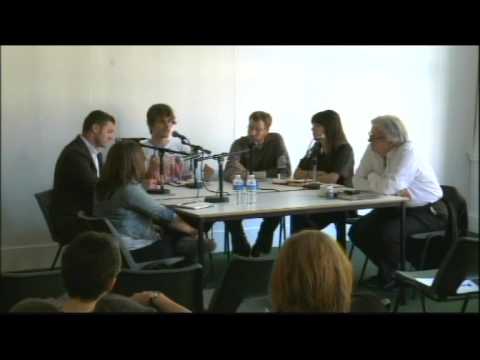
Lecture date: 2010-05-21
Mark invites the panel to present themselves.
Mollie Claypool introduces herself as a teacher at the AA, both in DRL and in third year HTS; also at the University of Reading.
Ryan Dillon follows, who also teaches in DRL and in first year HTS, and is working for EGG Office, a design firm in Los Angeles.
Jack Self, second year student.
Braden Engel, from North Dakota, former student of MA HCT, who is tutor in that program (2010) and Histories and Theories tutor at the University of Greenwich.
Finally, Eleanor Dodman is also in second year.
Mollie starts going back to the discussion on the archive, where she sees a lot of potential in the possibility they bring for students to find gaps or look for histories that unnecessarily were forgotten. In HTS, they address sixteen iconic buildings, not through a survey course, but in a very straight forward way, allowing student to talk about the differences, rather than discussing the things that they represent. Ryan refers to the disconnexion between the work of the studio and the history teaching; for him teaching is not so much about giving a catalogue, but about inviting students to utilize the past, manipulate it and see the link between what they are doing. Jack, mentions a sentence he read recently of Rancière, saying that “art is always a political act”. The concern of history and theory about what we might call architecture as art, rather than architecture as a technological expression, it understood because architecture as art, is the politics of space. He argues that the mistake made by a lot of unit masters is a separation of art as a formal activity from art as a political statement. He sees history and theory as a microcosms for a challenge that architecture as a profession is facing at the moment: the decline in interest in history and theory has got very little to do with the historians or the theoreticians, it has to do with the fact that it is not valued by unit masters and therefore not seen as relevant by the students who are partaking in those studios. He is referring to a-political units. The architect as a figure in society, if they wish to avoid obsolescence, it has to convince society of their political role. Eleanor intervenes, pointing out that it is up to the student whether or not hey combine their history and theory with the unit work. They are possible to combine at least in her case. The question to Braden it is still how architecture is tacked between the student and the tutor, as opposed to someone like a teacher. Mark wonders who in architectural history would fit in the AA: maybe not Wren, but Hawksmoor yes. Jack point out that the teaching of history in AA somehow relies in its opposition towards what everyone else is teaching. All architects think they are theorists, they are wrong, but how would they know.
The focus of the symposium is on the teaching of architectural history within architectural trainings. It is frequently admitted that architectural students do not find their history programmes useful or interesting. Why is this? The conference will address this question and consider how problems within architectural history might be productively changed by a different approach to the architectural past.
The AA has sought to reformulate its syllabus of how the issue of the past is dealt with in architectural terms. The symposium will consider ways in which the issue of the architectural past can be fashioned into a productive element in the training of an architect. Schedule: Friday 21 May10.30 Brett Steele (Director of AA), Welcome10.45 Mark Cousins (AA), Introduction 11.00 Reinhold Martin (Columbia University), Professional Histories 12.00 Brian Hatton (AA and John Moores University), Wandering in the Museum 2.00 Adrian Forty (Bartlett School, UCL) Dissecting the Cadaver 3.00 Irene Sunwoo (Princeton University), The Static Age 3.45 Panel discussion on Archives and Publishing, Tom Weaver (AA Files), Edward Bottoms (AA Library) and Irene Sunwoo 4.30 Tea5.00 Eyal Weizman (Goldsmiths) Forensic Architecture: only the criminal can solve the crime Saturday 22 May10.30 Mark Campbell (AA)11.30 Jeff Kipnis (Ohio State University), Honour Thy Bungling Epigone12.30 Lunch2.00 Mark Cousins (AA), Architecture and its Unconscious3.00 Panel discussion, Mollie Claypool (AA), Ryan Dillon (AA) and AA students. For feedback and comment please contact [email protected]